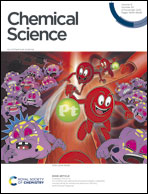Synthesis and electronic structure analysis of the actinide allenylidenes, [{(NR2)3}An(CCCPh2)]− (An = U, Th; R = SiMe3)†
Abstract
The reaction of [AnCl(NR2)3] (An = U, Th, R = SiMe3) with in situ generated lithium-3,3-diphenylcyclopropene results in the formation of [{(NR2)3}An(CH![[double bond, length as m-dash]](https://www.rsc.org/images/entities/char_e001.gif) C
C![[double bond, length as m-dash]](https://www.rsc.org/images/entities/char_e001.gif) CPh2)] (An = U, 1; Th, 2) in good yields after work-up. Deprotonation of 1 or 2 with LDA/2.2.2-cryptand results in formation of the anionic allenylidenes, [Li(2.2.2-cryptand)][{(NR2)3}An(CCCPh2)] (An = U, 3; Th, 4). The calculated 13C NMR chemical shifts of the Cα, Cβ, and Cγ nuclei in 2 and 4 nicely reproduce the experimentally assigned order, and exhibit a characteristic spin–orbit induced downfield shift at Cα due to involvement of the 5f orbitals in the Th–C bonds. Additionally, the bonding analyses for 3 and 4 show a delocalized multi-center character of the ligand π orbitals involving the actinide. While a single–triple–single-bond resonance structure (e.g., An–C
CPh2)] (An = U, 1; Th, 2) in good yields after work-up. Deprotonation of 1 or 2 with LDA/2.2.2-cryptand results in formation of the anionic allenylidenes, [Li(2.2.2-cryptand)][{(NR2)3}An(CCCPh2)] (An = U, 3; Th, 4). The calculated 13C NMR chemical shifts of the Cα, Cβ, and Cγ nuclei in 2 and 4 nicely reproduce the experimentally assigned order, and exhibit a characteristic spin–orbit induced downfield shift at Cα due to involvement of the 5f orbitals in the Th–C bonds. Additionally, the bonding analyses for 3 and 4 show a delocalized multi-center character of the ligand π orbitals involving the actinide. While a single–triple–single-bond resonance structure (e.g., An–C![[triple bond, length as m-dash]](https://www.rsc.org/images/entities/char_e002.gif) C–CPh2) predominates, the An
C–CPh2) predominates, the An![[double bond, length as m-dash]](https://www.rsc.org/images/entities/char_e001.gif) C
C![[double bond, length as m-dash]](https://www.rsc.org/images/entities/char_e001.gif) C
C![[double bond, length as m-dash]](https://www.rsc.org/images/entities/char_e001.gif) CPh2 resonance form contributes, as well, more so for 3 than for 4.
CPh2 resonance form contributes, as well, more so for 3 than for 4.
![Graphical abstract: Synthesis and electronic structure analysis of the actinide allenylidenes, [{(NR2)3}An(CCCPh2)]− (An = U, Th; R = SiMe3)](/en/Image/Get?imageInfo.ImageType=GA&imageInfo.ImageIdentifier.ManuscriptID=D1SC04666G&imageInfo.ImageIdentifier.Year=2021)
- This article is part of the themed collections: 2021 ChemSci Pick of the Week Collection and 2021 Chemical Science HOT Article Collection


 Please wait while we load your content...
Please wait while we load your content...